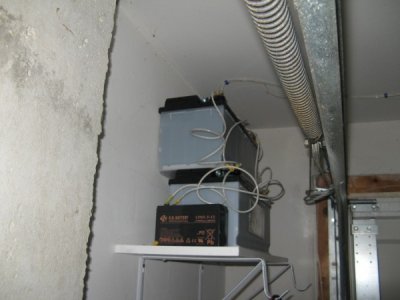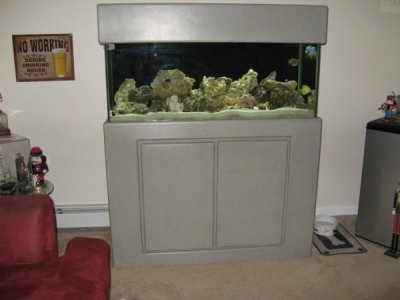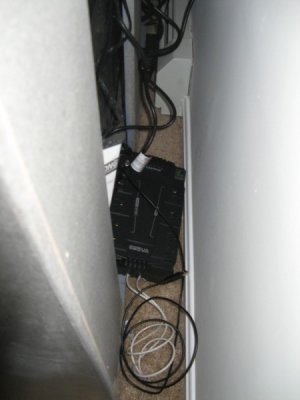jason77777
New member
So, it's winter up here in New England and I'm new to the saltwater aquarium scene. Thankfully, in my area the power grid is pretty robust so the power doesn't usually go out for more than a couple hours at a time, but that being said it DOES still go out. You never know when the next blizzard is going to hit and I'm without power for 18 hours. I got to thinking about what is going to happen to my aquarium if i'm shut down for an extended period of time?
I have a 75 gallon with a sump system. I keep all my heating equipment in the sump, so if I lose my return pump I lose all my heating capabilities, my circulation/filtration, and my aeration (from the skimmer and the circulating water).
Now, let me start by saying that I work at an European auto dealership. Sometimes the cars are too smart for their own good so they think they have a bad battery (computer calculation) when it is in fact still good. I got 2 110Ah batteries for free that still tested good. I know this is the most expensive part of the system so if that is cheating, then I guess I am a cheater.
The next step was figuring out how to convert DC to AC, keep the cells charged, and how to automatically switch over the power (if I am at work when the power drops or if it is in the middle of the night). At first I was thinking of an inverter, a maintainer, and some sort of AC relay wired into the inverter. Then I realized I could acomplish all of this with a computer UPS. A computer UPS uses a sealed 12v lead acid battery, trickle charges when necessary, and obviously provides a seamless switch-over.
I took a look at the bare essentials needed to sustain life in the aquarium and realized that all I REALLY need is the return pump and a heater. The tank can last for days or weeks without a skimmer (anyone who has had the pleasure of dosing sick fish knows this), the UV filter is not needed immediately, and the light is not necessary. My return pump is rated at 55 watts, and my heater is rated at 300 watts. So with those calculations all I need is 355 watts.
I found a suitable UPS at the local electronics store for $45 on sale. It is rated at 375 watts. I didn't want to keep lead acid batteries in the house (I have pets, and the wife won't like the look of two huge batteries and wiring on the living room floor. If you have one who allows that, hold onto her!!) Luckilly for me, my aquarium is right above my garage. I drilled a small hole from the living room to the garage, mounted a shelf in the corner (you are going to want to find some studs for this shelf. The batteries are 70lbs each), and ran the wiring. I wired the two big boys, and the 5Ah that came with the UPS in parallel so I now have 225Ah of capacity at 12v.
I used 10 gauge wiring for this set-up. I figured I was only running 10 feet and I shouldn't have more than 350 watts max. If you think about it, house wiring is 14 gauge and that is rated for 15A (1800 watts!). I removed the battery from the UPS (previously mentoined) and I connected the wiring from the batteries.
The batteries were already charged previously so I plugged it in and kept my fingers crossed. Everything worked perfectly. The UPS saw the batteries as normal and was actually charging them. I know this because I was getting a voltage increase at the batteries when the unit was unplugged and then plugged back in. Now, obviously the batteries will take hours or maybe even days to fully charge up again. In my area, that isn't a problem because the power usually comes back within a couple hours and the next storm is USUALLY a couple days away.
Now it was time to load the system up. I plugged in everything I have (filters, skimmer, light, etc). I put my heater and return pump on the "battery" side and everything else on the "non-battery" side. I fired up the software and plugged in the USB. Whoa, I was at 98% capacity!! I didn't realize the wattage rating was when it was running on AC power. So then I figured why plug all the items into the UPS if I wasn't even worried about running them when the power was out. I put everthing except the essentials back into the power strip. Now I had only the return pump and my heater.
Apparently, my pump pulls more than it is rated for (maybe the 4ft head?). It is more like 65-75 watts. Luckilly, my heater is rated for 300 watts but only pulls 250. This concerned me because I think that the heater can "ramp" it up if it needs to and that would put me at my rated capacity. I ordered a 250 watt heater which I'll set a couple degrees lower than the tank temp so it will only turn on if the temp drops in an emergency. 250 watts will get the job done in an emergency. I should have that in a couple days (hopefully no blizzards until then), but I have the heater back in the power strip for now.
After a couple function tests (yanking the plug out of the wall), I was very happy. The pump barely misses a beat and keeps on going. The battery voltage drops to about 12.3-12.4 and maintains well for at least 1/2 an hour. I didn't have the time to check it any longer today. I put everything back together and fit the unit in the back of my cabinet.
With my rated capacity 225Ah (2700WHr) and my power requirements 325w max, but more realistically 200w (that is based on 50% heater on time and 75w return pump) or lower I can run for 13.5 hours!! I also have the option to turn the systerm on and off and run a battery powered aerator. I can just turn the system on for 30 minutes at a time to keep the water heated and circulated. I can also run my skimmer (25 watts) because I now have a buffer with the smaller heater. If worst comes to worst, I can hook jumper cables up to the cars and hook them up to the battery!
Hopefully you enjoyed my write up,
Jason
I have a 75 gallon with a sump system. I keep all my heating equipment in the sump, so if I lose my return pump I lose all my heating capabilities, my circulation/filtration, and my aeration (from the skimmer and the circulating water).
Now, let me start by saying that I work at an European auto dealership. Sometimes the cars are too smart for their own good so they think they have a bad battery (computer calculation) when it is in fact still good. I got 2 110Ah batteries for free that still tested good. I know this is the most expensive part of the system so if that is cheating, then I guess I am a cheater.
The next step was figuring out how to convert DC to AC, keep the cells charged, and how to automatically switch over the power (if I am at work when the power drops or if it is in the middle of the night). At first I was thinking of an inverter, a maintainer, and some sort of AC relay wired into the inverter. Then I realized I could acomplish all of this with a computer UPS. A computer UPS uses a sealed 12v lead acid battery, trickle charges when necessary, and obviously provides a seamless switch-over.
I took a look at the bare essentials needed to sustain life in the aquarium and realized that all I REALLY need is the return pump and a heater. The tank can last for days or weeks without a skimmer (anyone who has had the pleasure of dosing sick fish knows this), the UV filter is not needed immediately, and the light is not necessary. My return pump is rated at 55 watts, and my heater is rated at 300 watts. So with those calculations all I need is 355 watts.
I found a suitable UPS at the local electronics store for $45 on sale. It is rated at 375 watts. I didn't want to keep lead acid batteries in the house (I have pets, and the wife won't like the look of two huge batteries and wiring on the living room floor. If you have one who allows that, hold onto her!!) Luckilly for me, my aquarium is right above my garage. I drilled a small hole from the living room to the garage, mounted a shelf in the corner (you are going to want to find some studs for this shelf. The batteries are 70lbs each), and ran the wiring. I wired the two big boys, and the 5Ah that came with the UPS in parallel so I now have 225Ah of capacity at 12v.
I used 10 gauge wiring for this set-up. I figured I was only running 10 feet and I shouldn't have more than 350 watts max. If you think about it, house wiring is 14 gauge and that is rated for 15A (1800 watts!). I removed the battery from the UPS (previously mentoined) and I connected the wiring from the batteries.
The batteries were already charged previously so I plugged it in and kept my fingers crossed. Everything worked perfectly. The UPS saw the batteries as normal and was actually charging them. I know this because I was getting a voltage increase at the batteries when the unit was unplugged and then plugged back in. Now, obviously the batteries will take hours or maybe even days to fully charge up again. In my area, that isn't a problem because the power usually comes back within a couple hours and the next storm is USUALLY a couple days away.
Now it was time to load the system up. I plugged in everything I have (filters, skimmer, light, etc). I put my heater and return pump on the "battery" side and everything else on the "non-battery" side. I fired up the software and plugged in the USB. Whoa, I was at 98% capacity!! I didn't realize the wattage rating was when it was running on AC power. So then I figured why plug all the items into the UPS if I wasn't even worried about running them when the power was out. I put everthing except the essentials back into the power strip. Now I had only the return pump and my heater.
Apparently, my pump pulls more than it is rated for (maybe the 4ft head?). It is more like 65-75 watts. Luckilly, my heater is rated for 300 watts but only pulls 250. This concerned me because I think that the heater can "ramp" it up if it needs to and that would put me at my rated capacity. I ordered a 250 watt heater which I'll set a couple degrees lower than the tank temp so it will only turn on if the temp drops in an emergency. 250 watts will get the job done in an emergency. I should have that in a couple days (hopefully no blizzards until then), but I have the heater back in the power strip for now.
After a couple function tests (yanking the plug out of the wall), I was very happy. The pump barely misses a beat and keeps on going. The battery voltage drops to about 12.3-12.4 and maintains well for at least 1/2 an hour. I didn't have the time to check it any longer today. I put everything back together and fit the unit in the back of my cabinet.
With my rated capacity 225Ah (2700WHr) and my power requirements 325w max, but more realistically 200w (that is based on 50% heater on time and 75w return pump) or lower I can run for 13.5 hours!! I also have the option to turn the systerm on and off and run a battery powered aerator. I can just turn the system on for 30 minutes at a time to keep the water heated and circulated. I can also run my skimmer (25 watts) because I now have a buffer with the smaller heater. If worst comes to worst, I can hook jumper cables up to the cars and hook them up to the battery!
Hopefully you enjoyed my write up,
Jason




